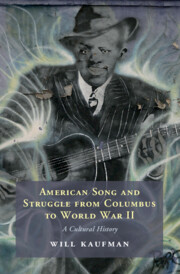Book contents
- American Song and Struggle from Columbus to World War II
- American Song and Struggle from Columbus to World War II
- Copyright page
- Praise for American Song and Struggle
- Dedication
- Contents
- Figures
- Preface
- Acknowledgments
- Introduction
- Chapter 1 Broken Spears and Songs of Sorrow
- Chapter 2 Good Newes from Virginia
- Chapter 3 A Capital Chop
- Chapter 4 If I Had but a Small Loaf of Bread
- Chapter 5 Where Today Are the Pequot?
- Chapter 6 There Is a Fountain Filled with Blood
- Chapter 7 A Tragedy That Beggared the Greek
- Chapter 8 Muscle, Blood, and Steel
- Chapter 9 Rule Anglo-Saxia
- Chapter 10 The Hand That Feeds You
- Chapter 11 We Are Many
- Chapter 12 100% American
- Chapter 13 We’re Up Against It Now
- Chapter 14 The Panic Is On
- Chapter 15 To Thee We Sing
- Conclusion
- Notes and Sources
- Song Index
- General Index
Chapter 10 - The Hand That Feeds You
Published online by Cambridge University Press: 30 July 2022
- American Song and Struggle from Columbus to World War II
- American Song and Struggle from Columbus to World War II
- Copyright page
- Praise for American Song and Struggle
- Dedication
- Contents
- Figures
- Preface
- Acknowledgments
- Introduction
- Chapter 1 Broken Spears and Songs of Sorrow
- Chapter 2 Good Newes from Virginia
- Chapter 3 A Capital Chop
- Chapter 4 If I Had but a Small Loaf of Bread
- Chapter 5 Where Today Are the Pequot?
- Chapter 6 There Is a Fountain Filled with Blood
- Chapter 7 A Tragedy That Beggared the Greek
- Chapter 8 Muscle, Blood, and Steel
- Chapter 9 Rule Anglo-Saxia
- Chapter 10 The Hand That Feeds You
- Chapter 11 We Are Many
- Chapter 12 100% American
- Chapter 13 We’re Up Against It Now
- Chapter 14 The Panic Is On
- Chapter 15 To Thee We Sing
- Conclusion
- Notes and Sources
- Song Index
- General Index
Summary
Conquered peoples are turned into sideshow exhibits at the St. Louis World’s Fair, with Filipinos singing “The Star-Spangled Banner” and Geronimo singing and dancing for spectators. Black composers fight against the deracialization of ragtime threatened by white popularizers like Irving Berlin and Lewis Muir, while Chinese opera singers work to challenge the orientalism and exoticism of a snowballing “Chinatown” craze in popular music. The walls of the Angel Island and Ellis Island detention centers are scrawled with anonymous songs of despair and outrage, and the corrido continues to challenge US hegemony with its portrayals of legendary outlaws like Gregorio Cortéz and Pancho Villa. George M. Cohan – “the man who owns Broadway” – emerges with his own muscular celebrations of US power. The cities are swelling with immigrants from Eastern and Southern Europe, and Tin Pan Alley tunesmiths warn them not to “Bite the Hand that Feeds You.” Immigrant performers like Adolf Philipp and Eduardo Migliaccio work to ease the path of assimilation for their fellow countrymen, and the Yiddish musical theater sinks its roots deeper into the foundations of US culture. Puccini’s US-themed operas – Madama Butterfly and The Girl of the Golden West – inspire Boston composer George Whitefield Chadwick to write The Padrone, his own operatic critique of immigrant exploitation.
Keywords
- Type
- Chapter
- Information
- American Song and Struggle from Columbus to World War 2A Cultural History, pp. 196 - 223Publisher: Cambridge University PressPrint publication year: 2022

